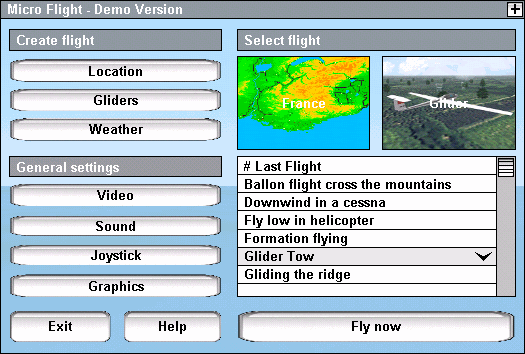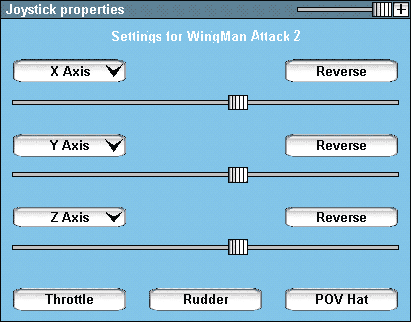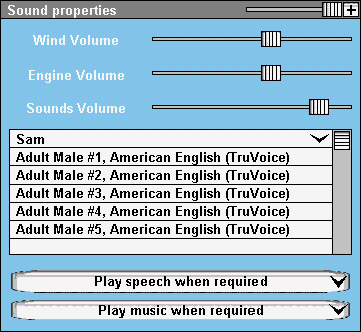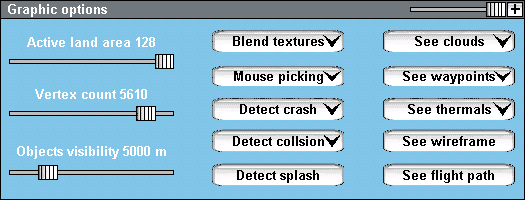user manual

Micro Flight has a simple and straight forward user inteface, the use of instruments, panels and menus is intuitive as possible and there is no need to remeber many keyboard commands.
After the program starts the opening screen is visble:

The right side of this screen allows you to select a flight and fly without further delay, select the flight from the list on the right, above you see the scenery and glider used in this flight.
The left side of the screen lets you select a location, weather and glider, atfer you select the things you want, press "Fly now" to begin your flight.
Joystick options:
Joystick is disabled by default, enable it by pressing the Joystick button and selecting the axes you wish to use.

If your joystick has a throttle or a slider, select the Z axis or the Throttle option, most new joysticks use the Z axis instead of throttle.
If your joystick has a point of view switch ( "Hat" ) select the POV Hat option.
If your joystick has a rudder axis which is not connected to the Z Axis, select the Rudder option.
Sensitivities for the X, Y, Z, Throttle axes can be adjusted using the three sliders, for X, Y axes the direction can be reversed by selecting the Reverse button.
Sound options:
Sound options are enabled by default, If you wish to change sound settingfs press the Sound button and select the following options.

If you have Microsoft Speech API 4 installed and some speaker voices, you will see the avaialble speakers appear on the list, if this list is empty you need to install these components if you wish to hear speech inside the program.
Notes:
- Download DirectX8 or better from here
- Download the Microsoft speech API here or here
- Download default speaker here or here
The sounds in the program can be controlled by adjusting the three sliders, these adjust the wind sound, the engine sound and the other sounds which are not played contiuousely.
The intro music, and music which may be played during flight can be switched off by clearing the "Play music" option.
The speech option can be disabled by clearing the "Play speech" option.
Video options:
To adjust the video options of the program press the video button, this will show the following screen:

It is recommended to work with "Render inside window" option, as this gives more control over the program, the application can be minimized, restored, change size and be closed more easily.
However if you wish to run the program in full screen mode, this may give boosted performance on some video cards, to select this mode clear the "Run inside window" option.
To set the screen mode in full screen mode, select the desired mode from the list of screen modes, some video cards do not show refresh rate, in that case select the mode by size alone.
Pressing Accept will apply the selected screen mode.
Graphic options:
To adjust the graphic options of the program press the graphics button, this will show the following screen:

The three sliders on the left control the complexity of the scene and can have big influence on frame rates.
The "Active land area" controlls the size of the terrain grid, the larger it is the larger the grid will be, the number of polygons/vertices rendered is relative to the square of this number.
If your frame rates drop below 20 fps it is recommended to change the active land area to 80 or less, instead of the default 128.
The "Vertex count" slider controlls the amount of optimization made on the grid and the vertex count after optimization.
The "Objects visibility" slider controlls the visibility of land objects, this has great effect when the scene is dense with objects.
The "Blend textures" option enables the blending of land textures, this blending makes the land look seamless, but at the same time requires processing time and graphic memory, if you experience low frame rates you may try to disable this option.
This option has no effect on photoreslistic scenery where the textures are taken directly from the photo and not blended in runtime.
Mouse picking:
The "Mouse picking" option enables you to manipulate instruments, handles and control surfaces by pressing them with the left mouse button and moving the controlled item.
As you press on the item, the mouse cursor will show the direction of possible manipulation.
When the joystick is turned off, the mouse picking can be used to control the plane directly by moving the stick, throttle, rudder and handles inside the cockpit.
When picking and joystick are turned off, the mouse movement is used as stick input.
An example of mouse picking can be seen in the following image:
 |
|
| 1. flaps - press and move up/down | 4. stick - press and move in all directions |
| 2. rudder - press and move left/right | 5. trim - press and move up/down |
| 3. gear - press and move up/down | 6. cable - press and move up/down |
Simulating a pre-flight check:
Mouse picking can be used for moving control surfaces outside the plane, you can simulate a pre-flight check in the following way:
- Press F2 to be in chase view.
- Open the joystick menu and make sure the joystick axes are disabled.
- Move the control surfaces of the plane as you would have when making a pre-flight check.
Crash detection:
Crash testing and object collision can be enabled by selecting the following options:
Detect crash - check if plane has been broken by overstress, or ground impact.
Detect collsion - check if plane has collided with another plane or object.
Detect splash - check if plane is at sea level and assume water impact.
Visibility:
These options enable the visibility of the following items:
See clouds - transparent clouds cuase massive frame rate loss, this option disables them.
See waypoints - waypoints appear as yellow markers in the scene, they can be made invisble with this option.
See wireframe - shows the entire scene in wireframe, this option is usefull when changing land resolution and vertex count, and also when being towed by a plane that is hidded by your instrument panel.
See flight path - shows the flight path in the scene, normally visible in the map only, this option is usefull when exploring an aerobatic maneuver such as a loop, or when using the flight rfeplay to explore parts of the flight in detail.
The following items
have an adverse effect on frame rates :
|